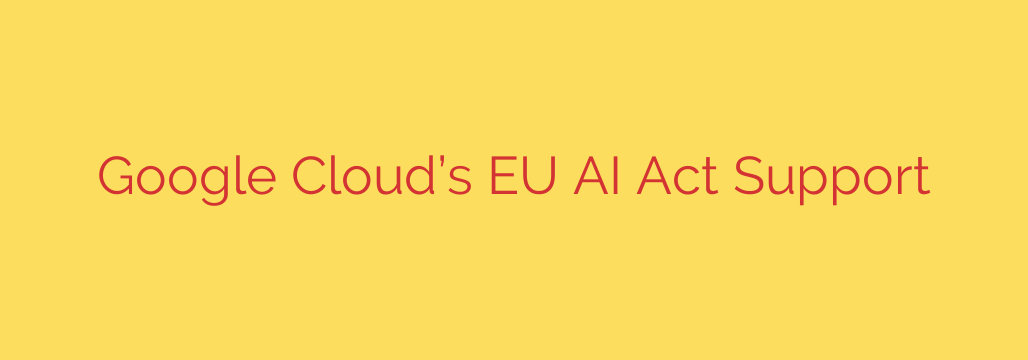
Navigating the EU AI Act: How Google Cloud Can Help You Achieve Compliance
The European Union’s AI Act is a landmark piece of legislation poised to reshape how businesses develop, deploy, and manage artificial intelligence systems. As the world’s first comprehensive AI law, it establishes a new global standard for AI regulation. For organizations leveraging AI, understanding the path to compliance is not just a legal necessity—it’s a strategic imperative.
The good news is that you don’t have to navigate this complex landscape alone. Leading cloud platforms are stepping up to provide the tools and infrastructure necessary to build compliant, responsible AI solutions. Here’s a detailed look at how Google Cloud is structured to support your journey toward EU AI Act compliance.
Understanding the EU AI Act’s Risk-Based Framework
At its core, the EU AI Act is not a one-size-fits-all regulation. It uses a risk-based approach, categorizing AI systems into four tiers:
- Unacceptable Risk: AI systems that are considered a clear threat to the safety and rights of people. These are banned outright.
- High-Risk: AI systems used in critical sectors like healthcare, law enforcement, and critical infrastructure management. These face the most stringent requirements.
- Limited Risk: Systems like chatbots, which must adhere to transparency obligations so users know they are interacting with an AI.
- Minimal Risk: AI applications like spam filters or video games, which have no additional legal obligations.
Your compliance obligations depend entirely on where your specific AI application falls within this framework. Crucially, the responsibility for classifying and ensuring the compliance of an AI system lies with the organization deploying it. Your cloud provider’s role is to equip you with the capabilities to meet those obligations.
A Shared Responsibility Model for AI Compliance
Google Cloud operates on a shared responsibility model. While you are responsible for the AI systems you build on the platform, Google Cloud provides the secure, transparent, and governable infrastructure to help you meet the Act’s requirements. This commitment is built on a long-standing foundation of responsible AI principles.
The platform offers a suite of tools and features specifically designed to address the key pillars of the EU AI Act, including transparency, data governance, and system robustness.
Key Features for Transparency and Governance
Transparency is a cornerstone of the EU AI Act, especially for high-risk systems. You must be able to document how your model was built, what data it was trained on, and how it performs.
- Comprehensive Model and Data Transparency: Google Cloud champions this through tools like Model Cards and Datasheets for Datasets. Think of these as “nutrition labels” for your AI. Model Cards provide a structured overview of a model’s performance, limitations, and ethical considerations. Similarly, Datasheets offer crucial details about the datasets used for training, helping you address questions of bias, provenance, and suitability.
- Robust Data Governance: The Act places heavy emphasis on data quality and oversight. You need to ensure the data used to train your models is relevant, representative, and free of errors and biases. Google Cloud’s data management tools provide the foundation for this by enabling strong access controls, data lineage tracking, and detailed auditing. This traceability is essential for demonstrating compliance.
- Responsible AI by Design: Tools within Vertex AI, such as the Model Garden and Generative AI Studio, are built with responsible AI practices in mind. They offer access to models that come with extensive safety filtering and documentation, providing a head start on building trustworthy applications.
Ensuring Robustness and Security for High-Risk Systems
For AI systems classified as high-risk, the EU AI Act mandates high levels of accuracy, robustness, and cybersecurity. Your AI must be resilient against errors and attempts to manipulate it.
Google Cloud’s secure-by-design infrastructure provides the necessary safeguards. Features like Customer-Managed Encryption Keys (CMEK) and VPC Service Controls give you granular control over your data and resources, helping to isolate your AI workloads and protect them from unauthorized access. This secure foundation is critical for building the resilient systems the regulation demands.
Actionable Steps for Your Compliance Journey
Navigating the EU AI Act is an ongoing process, but you can take clear steps today to prepare.
- Assess Your Risk: The first and most important step is to carefully evaluate your AI use cases and determine which risk category they fall into under the Act. This will define the scope of your compliance efforts.
- Prioritize Transparency: Immediately begin leveraging tools like Model Cards and Datasheets. Document everything about your models and data from the very beginning of the development lifecycle.
- Implement Strong Governance: Use Google Cloud’s data governance and security features to ensure the integrity and protection of your data and AI systems. Enforce the principle of least privilege and maintain clear audit trails.
- Stay Informed: The AI landscape is evolving rapidly. Regularly consult Google Cloud’s official documentation and compliance resources to stay updated on the latest tools and best practices for meeting your regulatory obligations.
Ultimately, the EU AI Act represents a significant step toward creating a trustworthy AI ecosystem. By partnering with a capable cloud provider and utilizing the right tools, you can not only achieve compliance but also build more reliable, fair, and secure AI solutions for the future.
Source: https://cloud.google.com/blog/products/identity-security/google-clouds-commitment-to-eu-ai-act-support/








